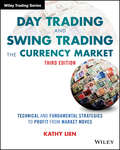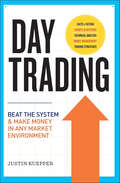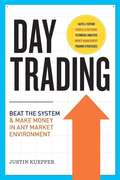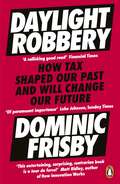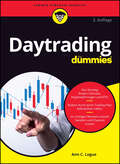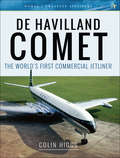- Table View
- List View
Day Trading Stocks the Wall Street Way: A Proprietary Method For Intra-Day and Swing Trading (Wiley Trading)
by Josh DiPietroAvoid bogus trading systems, learn from a real day trader, and make consistent profits day trading stocks Day Trading Stocks the Wall Street Way: A Proprietary Disclosure on Intra-Day Trading and Swing Trading Equities provides a real-world guide to successful day trading, and gives you the tools, techniques, and tested, reliable methods you need to trade like the pros. Written by a seventeen-year day trading veteran, this guide talks you down from the industry hype to give you a realistic grounding in self-discipline, consistency, and patience while teaching you the hard skills you need to have a real chance of success. Avoid losses by swerving from the typical beginner's path of seminars, software, and major brokerage houses, and instead develop the insights that lead to real, long-term profits. With an engaging and humorous tone, the author relates his own experiences and lessons learned to teach you the do's, the don'ts, and the ingredients for success. You'll discover Josh DiPietro's FUSION TRADING SYSTEM—a proven method developed from years of reliability testing. He'll show you how intra-day setups and swing trading setups can be merged to develop a perfect trade. The surest path to failure and tremendous financial loss begins with the over-eager, overly optimistic amateur trader who sees day trading as a quick and easy path to wealth. This book gives you a much more realistic outlook, and the fundamentals you need to make the most of the market. Get an honest perspective on real-world day trading Gain the wisdom of experience and avoid common pitfalls Learn the framework to Josh Dipietro's profitable FUSION TRADING SYSTEM A poorly defined trading approach will cost you more money than you will make, rendering your day trading venture a potentially damaging net loss. Day Trading Stocks the Wall Street Way: A Proprietary Disclosure on Intra-Day Trading and Swing Trading Equities teaches you the avoidance of loss, the discipline, and the transparent strategies of success, so you can play the market to win.
Day Trading and Swing Trading the Currency Market
by Kathy LienDiscover a variety of technical and fundamental profit-making strategies for trading the currency market with the Second Edition of Day Trading and Swing Trading the Currency Market. In this book, Kathy Lien-Director of Currency Research for one of the most popular Forex providers in the world-describes everything from time-tested technical and fundamental strategies you can use to compete with bank traders to a host of more fundamentally-oriented strategies involving intermarket relationships, interest rate differentials, option volatility, news events, and central bank intervention.
Day Trading: Beat the System and Make Money in Any Market Environment
by Justin KuepperAll You'll Ever Need to Trade from Home When most people hear the term "day trader," they imagine the stock market floor packed with people yelling 'Buy' and 'Sell' - or someone who went for broke and ended up just that. These days, investing isn't just for the brilliant or the desperate—it's a smart and necessary move to ensure financial wellbeing. To the newcomer, day trading can be a confusing process: where do you begin, and how can you approach trading in a careful yet effective way? With Day Trading you'll get the basics, then: Learn the Truth About Trading Understand The Psychology of Trading Master Charting and Pattern-recognition Study Trading Options Establish Trading Strategies & Money Management Day Trading will let you make the most out of the free market from the comfort of your own computer.
Day Trading: Beat the System and Make Money in any Market Environment
by Justin KuepperAll You'll Ever Need to Trade from Home <p><p> When most people hear the term "day trader," they imagine the stock market floor packed with people yelling 'Buy' and 'Sell' - or someone who went for broke and ended up just that. These days, investing isn't just for the brilliant or the desperate--it's a smart and necessary move to ensure financial wellbeing. <p><p> To the newcomer, day trading can be a confusing process: where do you begin, and how can you approach trading in a careful yet effective way? <p><p>With Day Trading you'll get the basics, then: <p>Learn the Truth About Trading <p>Understand The Psychology of Trading <p>Master Charting and Pattern-recognition <p>Study Trading Options <p>Establish Trading Strategies & Money Management <p><p>Day Trading will let you make the most out of the free market from the comfort of your own computer.
DayTwo: Going to Market with Gut Microbiome
by David Lane Ayelet IsraeliDayTwo is a young Israeli startup that utilizes research on the gut microbiome and machine learning algorithms to deliver personalized nutritional recommendations to its users in order to minimize blood sugar (glycemic) spikes after meals. After a first year of trial rollout in Israel, CEO Lihi Segal and her team are devising a go-to-market plan for DayTwo. The team is considering several target markets ranging from people with diabetes to professional athletes, as well as several distribution strategies including selling direct to consumers or through partnerships with health-care professionals or insurance companies. These decisions affect DayTwo's costs, pricing, positioning, distribution channels, marketing efforts, and product development. <p><p>The case is designed to illustrate the challenges associated with bringing a new and complex product to market. It allows for a rich discussion of market segmentation and targeting, distribution channels, and business models. It allows for a debate around growth decisions, while considering the tradeoff of short term versus long term gains and success. The goal of the case is to come up with a go-to-market strategy for a new startup. Students have to analyze the company and its strengths and weaknesses, as well as its potential customers, collaborators, and competitive environment, and deliver a well-formulated action plan. This plan includes pricing, distribution, products, and advertising recommendation.
Daylight Robbery: How Tax Shaped Our Past and Will Change Our Future
by Dominic FrisbyDeath and taxes are our inevitable fate. We've been told this since the beginning of civilisation. But what if we stopped to question our antiquated system? Is it fair? And is it capable of serving the needs of our rapidly-changing, modern society? In Daylight Robbery, Dominic Frisby traces the origins of taxation, from its roots in the ancient world, through to today. He explores the role of tax in the formation of our global religions, the part tax played in wars and revolutions throughout the ages, why, at one stage, we paid tax for daylight or for growing a beard. Ranging from the despotic to the absurd, the tax laws of the past reveal so much about how we got to where we are today and what we can do to build a system fit for the future.Featured on Stepping up with Nigel Farage'An important book for investors in gold and bitcoin' - Daniela Cambone, Stansberry Research'This entertaining, surprising, contrarian book is a tour de force!' - Matt Ridley, author of The Evolution of Everything'In this spectacular gallop through history, Frisby shows how taxation has warped, stunted and thwarted human progress' - Mark Littlewood, Director General, Institute of Economic Affairs'Frisby's historical interpretation and utopian ideas will outrage Left and Right' - Steve Baker, MP for Wycombe and Member of the House of Commons Treasury Committee 'Fascinating book which exposes the political and economic basis of tax. A must read for those of us who believe in simpler, lower taxes' - Rt Hon Liz Truss, MP for South West Norfolk, Secretary of State for International Trade and President of the Board of Trade
Daylighting and Integrated Lighting Design (PocketArchitecture)
by Christopher Meek Kevin Van WymelenbergDaylighting and Integrated Lighting Design provides architects, building designers, and students clear direction for the successful inclusion of daylight and integrated electric light in buildings. It presents design teams with the performance analysis resources, energy saving estimates and user satisfaction results they need in order to make informed decisions regarding daylighting and lighting design. Written by two well-known experts in the field, the book provides: critical geometric and material relationships along with proven design process activities, offered in a quick-reference format, with sufficient context to address the range of associated issues present in any building project both the "fundamentals" and "applications" which cover design concepts and practice activities applicable to all integrated lighting projects specific directives for how the concepts covered are applied in a range of common design scenarios, including architectural rules-of-thumb, instructions for ensuring visual comfort, and preferred approaches for electric lighting control integration. In demonstrating these necessary insights to designers, the authors employ an iterative analysis of common "daylighting patterns" and illustrate and annotate both successful and unsuccessful examples via built form and simulation. Part of the PocketArchitecture series, this is the ideal pocketbook for any designer serious about reducing the energy impact of their buildings.
Days of Destruction, Days of Revolt
by Chris Hedges Joe SaccoNamed a Best Book of the Year by Amazon.com and the Washington PostThree years ago, Pulitzer Prize-winner Chris Hedges and award-winning cartoonist and journalist Joe Sacco set out to take a look at the sacrifice zones, those areas in America that have been offered up for exploitation in the name of profit, progress, and technological advancement. They wanted to show in words and drawings what life looks like in places where the marketplace rules without constraints, where human beings and the natural world are used and then discarded to maximize profit. Days of Destruction, Days of Revolt is the searing account of their travels.
Days of Slaughter: Inside the Fall of Freddie Mac and Why It Could Happen Again
by Susan Wharton GatesThe untold story of the disastrous financial and ethical unwinding of Freddie Mac.In September 2008, beset by mounting losses on high-risk mortgages and mortgage securities, the Federal Home Loan Mortgage Corporation teetered on the brink of insolvency. Fearing that confidence in the housing market would collapse completely if Freddie Mac and its competitor Fannie Mae failed, the US government made the difficult decision to place the two firms into conservatorship, taking control away from shareholders. Although the taxpayer commitment of hundreds of billions was meant to stabilize the housing finance system, Freddie’s fall at the start of the financial crisis set off shockwaves around the world. In Days of Slaughter, Susan Wharton Gates, a former 19-year Freddie Mac employee and vice president of public policy, provides a vivid eyewitness account of the competing economic and political forces that led to massive losses for shareholders, investors, homeowners—and taxpayers. With a keen eye to the policy landscape, Gates relates the fateful decisions that led to Freddie Mac’s downfall and desperate rescue. She also examines today’s worrisome headlines about potential future bailouts, the uneven housing recovery, and stymied congressional reform efforts. Throughout the book, Gates argues convincingly that policymakers will be unable to safely reform the massive housing finance system that currently rests squarely on taxpayer shoulders without addressing deeper issues of ideology, moral hazard, and interest group politics.The first book to tell the story of Freddie Mac from an insider perspective—while casting a prophetic eye to the future—this first-hand account of housing policies, complex financial transactions, and the crazy quilt of federal and state actors involved in the Great Recession is a must-read. A cautionary tale of failed policies and corporate mismanagement that compellingly addresses previously unexplored issues of political ideology, organizational dynamics, and ethics, Days of Slaughter will appeal to readers everywhere who want a fuller explanation of what went awry in the US housing market.
Dayton Beer: A History of Brewing in the Miami Valley (American Palate)
by Timothy R. GaffneyThe story of beer in Dayton and the Miami Valley is as old as the region's first settlers, who brought their brewing methods with them from Europe. From humble origins, the Schwind brothers founded a Dayton brewing dynasty. Adam Schantz arrived penniless and amassed a fortune as one of the city's early brewers. Martha Vorce, one of the region's several unheralded woman brewers, was running the Springfield Brewery a decade before Eliza "Mother" Stewart gained fame there as a temperance leader. Although Prohibition swiftly destroyed this flourishing industry, today's local craft brewers promise to keep good beer and good times flowing for many years to come. Join local author Tim Gaffney as he explores the Valley's brewing heritage.
Dayton's Department Store
by Mary FirestoneDayton's department store, grand in scope and company spirit, enjoyed a century in the limelight as one of the nation's leading retailers. Its disappearance has been a challenge to the community, but it is a sign of the times, as many other urban department stores have shared the same fate. Originally called Goodfellows, the store got its start in 1902 when real estate investor and banker George Draper Dayton became a silent partner in the business. He soon took over the company but had to learn the ropes of retail as he went along since he had never intended to become a merchant. The early years were not without struggles, but Dayton's department store was nevertheless an instant hit with its daylight-filled aisles, generous return policies, and quality merchandise. The Minneapolis store became a vibrant self-contained community with a post office, newspaper, infirmary, laundry, bakery, and even a college. "Daytonians" worked and played together around the clock, in baseball and bowling teams, glee clubs, and orchestras. Over time, the reach of Dayton's extended far into the upper Midwest, with stores in North Dakota, South Dakota, and Wisconsin, including the development of the nation's first indoor mall.
Daytrading für Dummies (Für Dummies)
by Ann C. LogueDer schnelle Handel mit Aktien, Währungen, Optionen oder Futures bietet riesige Gewinnchancen, birgt aber auch bedeutende Risiken. Ann C. Logue zeigt verständlich auf, wie Sie als Anleger die Möglichkeiten des Daytrading planvoll nutzen und dabei finanziell nicht zu viel wagen. Von der Auswahl der Basiswerte, der Auswertung von Charts über die Bestimmung der Positionsgrößen bis zum Stressmanagement beschreibt die Autorin, wie Sie professionell handeln statt zu zocken.
Daytrading für Dummies (Für Dummies)
by Ann C. LogueDer schnelle Handel mit Aktien, Währungen, Optionen oder Futures bietet riesige Gewinnchancen, birgt aber auch bedeutende Risiken. Ann C. Logue zeigt verständlich auf, wie Sie als Anleger die Möglichkeiten des Daytrading planvoll nutzen und dabei finanziell nicht zu viel wagen. Von der Auswahl der Basiswerte, der Auswertung von Charts über die Bestimmung der Positionsgrößen bis zum Stressmanagement erfahren Sie, wie Sie professionell handeln statt zu zocken. Lernen Sie Ihre Möglichkeiten kennen, entwickeln Sie eine Strategie und beginnen Sie mit dem Traden!
De Amerikaanse Zaken Startgids Voor LOCKSMITH
by Mark J. AllenOnze nuchtere, gemakkelijk toe te passen, stapsgewijze handleidingen voor het starten van een eigen bedrijf, zijn de snelste en gemakkelijkste manier om volledig operationeel te maken. We hoeven geen leer je hoe je een slotenmaker... maar bieden wij u de beste adviezen krijgen over hoe u uw nieuwe bedrijf… vanaf vandaag!
De Beers Consolidated Mines Ltd. (A)
by Pankaj Ghemawat Toby LenkDescribes the problems facing De Beers at the start of 1983. De Beers had, since its formation in 1888, exercised a large measure of control over the world supply of diamonds. In 1983, the company itself mined over 40% of the world's natural diamonds and, through marketing arrangements with other producers, distributed over 70%. For 50 years up to 1983 the company had never lowered its prices and, overall, had raised them significantly ahead of the rate of inflation. However, in 1983 the company was faced with a series of problems that threatened the structure it had so carefully built. First, a large producing nation had stopped selling through De Beers. Second, new discoveries meant that the annual supply of mined diamonds would double by 1986. Finally, the industry was experiencing its worst slump since the 1930s, resulting in a significant deterioration in the company's financial position. Describes the structure and economics of the diamond industry and asks the student to decide whether or not De Beers should abandon the business strategy it had pursued for nearly a century.
De Beers at the Millennium
by Pankaj Ghemawat Sonia MarcianoAt the time of the millennium, diamond demand was threatened by an increasing awareness among jewelry customers that diamond production and trading in some countries was being linked to growing inequities and human rights violations. This, in turn, had an impact on De Beers' reputation and consumer confidence in the diamond as a product that represented integrity, love, and commitment. In 2000, De Beers' sustainability depends on the ability of its leaders to shift the paradigm of both the firm and its context and embrace a distinctly different strategy.
De Beers: Addressing the New Competitiveness Challenges
by Michael E. Porter Sonia Marciano Alyson WarhurstTraces the development of De Beers and the diamond industry from its inception in the mid-1800s to the year 2000. Discusses De Beer's history and strategy as the industry leader and its role in industry development. Enables deep examination of the interdependence of companies and the locations and communities in which they operate and the role of a company in economic and social development. In 2000, De Beers faces critical choices about both its economic and social policies and how they interrelate.
De Bow's Review: The Antebellum Vision of a New South (New Directions In Southern History Ser.)
by John F. KvachA study of the nineteenth-century magazine from the American South, its editor, and influence on the region.In the decades preceding the Civil War, the South struggled against widespread negative characterizations of its economy and society as it worked to match the North’s infrastructure and level of development. Recognizing the need for regional reform, James Dunwoody Brownson (J. D. B.) De Bow began to publish a monthly journal?De Bow’s Review?to guide Southerners toward a stronger, more diversified future. His periodical soon became a primary reference for planters and entrepreneurs in the Old South, promoting urban development and industrialization and advocating investment in schools, libraries, and other cultural resources. Later, however, De Bow began to use his journal to manipulate his readers’ political views. Through inflammatory articles, he defended proslavery ideology, encouraged Southern nationalism, and promoted anti-Union sentiment, eventually becoming one of the South’s most notorious fire-eaters.In De Bow’s Review: The Antebellum Vision of a New South, author John Kvach explores how the editor’s antebellum economic and social policies influenced Southern readers and created the framework for a postwar New South movement. By recreating subscription lists and examining the lives and livelihoods of 1,500 Review readers, Kvach demonstrates how De Bow’s Review influenced a generation and a half of Southerners. This approach allows modern readers to understand the historical context of De Bow’s editorial legacy. Ultimately, De Bow and his antebellum subscribers altered the future of their region by creating the vision of a New South long before the Civil War.“Kvach fills a surprising gap in the history of the nineteenth-century South with this elegantly written biography of the enigmatic J. D. B. De Bow. The work represents an important contribution to a growing historiography exploring the presence of a middle-class commercial culture in the pre–Civil War South and challenging long-held views of a static socioeconomic world of planters and plain folk.” —Bruce W. Eelman, author of Entrepreneurs in the Southern Upcountry: Commercial Culture in Spartanburg, South Carolina, 1845-1880“An insightful, original, deeply researched work of scholarship. Examining not only the career of journalist J. D. B. De Bow but also the readers who responded enthusiastically to his call for economic diversification, John F. Kvach helps us see the nineteenth-century South in a new way, undistorted by the stark, artificial line so many historians have drawn to separate the so-called Old South from the New.” —Stephen V. Ash, author of A Massacre in Memphis: The Race Riot That Shook the Nation One Year after the Civil War“DeBow was the antebellum South’s most prominent advocate of economic modernization and industrialization, and one of its most vitriolic secessionists. John Kvach explores this seeming paradox, and gives us as well a careful description of DeBow’s subscribers and followers.” —J. Mills Thornton, University of Michigan
De Escravo a Empresário Como criei a minha própria empresa
by Franklin A. Díaz Lárez José BatistaAprenda de uma forma agradável a montar um negócio e a criar uma fonte de rendimentos própria, através deste relato em primeira mão de alguém que o conseguiu fazer. Esta é a narrativa autobiográfica do caminho de um homem desesperado em busca de soluções para os seus aflitivos problemas financeiros. Depois de um longo processo de reflexão e autocrítica decide abandonar o seu posto de trabalho e criar a sua própria empresa. Consegue-o, mas não sem antes ter de superar dezenas de obstáculos, dificuldades e contrariedades. Um livro escrito em forma de narrativa autobiográfica, por vezes cómica, que descreve a epopeia do autor para se tronar empresário. Sem recurso a tediosas descrições conceptuais, normativas ou académicas, relata antes uma insólita estória em que o protagonista vai superando obstáculos enormes e dificuldades aparentemente intransponíveis, até atingir finalmente a sua tão almejada independência financeira. Aprenda de uma forma agradável a montar um negócio e a criar uma fonte de rendimentos própria, através deste relato em primeira mão de alguém que o conseguiu fazer. Dedicado a todos os que desejam libertar-se para sempre do jugo das formas contemporâneas de escravidão laboral, e da cruel e dramática incerteza do desemprego.
De Facebook politici en de traditionele politici.
by Paula Hendrayani-Paulissen Wael El-ManzalawyVoorwoord De wereld zag miljoenen Arabieren op de revolutionaire pleinen demonstreren. Een revolutie die op Facebook en Twitter begon. Zoals op bijvoorbeeld "We zijn allemaal Khaled Saeed pagina." Zij waren het die de eerste demonstratie in de Egyptische revolutie organiseerde. Dit boek is een poging om het fenomeen van de Facebook-politici in het Midden-Oosten te analyseren. Mijn ervaring als Facebook-politicus gaf me de kans om het fenomeen van binnenuit te analyseren en te bekritiseren. Facebook is niet alleen een medium dat sommige politici gebruiken om hun ideeën te verspreiden. Het is een virtuele wereld die haar banden met de werkelijke wereld heeft. We worden nu met een zeer belangrijke vraag geconfronteerd: Zijn de Facebook politici virtuele of feitelijke politici? U kunt het antwoord tijdens het lezen van dit boek vinden, maar u moet begrijpen dat de Facebook-politici zich tussen twee werelden verplaatsen: de virtuele wereld en de werkelijke. Misschien hadden de grondleggers van Facebook niet verwacht dat de Facebook-pagina's effectief genoeg zijn om revoluties tot stand te brengen. De grondleggers van Facebook zetten de zaden die de Facebook-gebruikers lieten groeien tot de vruchten van de revolutie konden worden geoogst. De Facebook revoluties waren zeer inspirerend. Vele miljoenen demonstranten protesteerden tegen de tirannie. De tirannie van de heersers in de Arabische wereld was verschrikkelijk, de revoluties waren verbazingwekkend. De wereld van de Facebook-politici heeft speciale karakteristieken. De vergelijking tussen de Facebook-politici en de traditionele politici is een hele interessante. Een ander probleem dat in dit boek wordt besproken is de toekomst van de Facebook-politici.
De Ferrari a los Rolling Stones: Los secretos de los mejores equipos del mundo
by Khoi Tu¿Qué tienen en común el equipo de fórmula 1 de Ferrari con los Rolling Stones o con los estudios Pixar?: que su éxito no se basa en la suma de sus individuos con talento sino en los superequipos que crearon. Toda organización, sea una pequeña empresa, una gran corporación o un club deportivo, vive o muere en función de su capacidad para trabajar en equipo. En un mundo que se mueve cada vez más rápidamente y que está tan interconectado, la necesidad de trabajar en equipo es hoy más importante que nunca. Khoi Tu, el especialista mundial en equipos de alto rendimiento, explica cómo lograr que sus equipos alcancen de forma constante unos resultados excelentes y sean capaces de salir reforzados de las inevitables crisis que tendrán que afrontar en un momento u otro. De Ferrari a los Rolling Stones desvela el funcionamiento interno y los momentos críticos de siete equipos excepcionales, entre los que se encuentran la Cruz Roja, los estudios de animación Pixar o el equipo de Ferrari de Fórmula 1. El libro define siete ingredientes imprescindibles en todo equipo excepcional: 1.Compartir un objetivo común2.Potenciar el desarrollo de líderes3.Hacer una selección acertada de sus miembros4.Generar las condiciones propicias para el éxito5.Mantener la cohesión interna6.Administrar bien los conflictos7.Impulsar el cambio Reseñas:«Khoi Tu desmitifica y desentraña aquello que es realmente necesario para crear equipos de alto rendimiento. Aconsejo a todos los interesados en cómo trabajar en equipo que se sumerjan en la lectura de este libro.»Manfred Kets de Vries, INSEAD «Khoi Tu posee una gran capacidad de motivación, y una enorme curiosidad, que procede de su voluntad de buscar soluciones a cuestiones que parecen irresolubles.»Sir Jackie Stewart, campeón mundial de Fórmula 1 «Las empresas y las organizaciones brillantes parecen muy sencillas desde fuera, pero sus mecanismos y su velocidad suelen ser impresionantes. Para lograrlo se necesitan buenos equipos, liderazgo, excelentes relaciones personales y algo de magia. De todo esto habla el libro. ¡Enhorabuena, Khoi!»Jamie Oliver, cocinero
De Gandía a la Casa Blanca: Cómo conseguí el éxito profesional usando el deporte como herramienta
by Rubén Figueres«Que no os engañen, lo que Rubén ha conseguido no está al alcance de cualquiera. Afortunadamente, su libro, sí.»Risto Mejide, escritor y publicista.Mi nombre es Rubén Figueres Alario. Nací en Gandía en el seno de una familia trabajadora y a los veinticuatro años me marché a Estados Unidos para probar suerte y mejorar mi inglés. Llegué a Chicago sin trabajo, sin visado, con muy pocos ahorros y sin conocer a nadie, pero gracias a mi pasión por el deporte alcancé el éxito personal y profesional.Cuando llegué allí creí que nada me haría tan feliz como encontrar un empleo en una de las grandes empresas de publicidad del mundo. Me esforcé mucho y trabajé en gimnasios, en cafeterías, en hoteles... todo para lograr mi objetivo. Sin embargo, cuando lo conseguí, no tardé en darme cuenta de que no me gustaba formar parte de un sistema de trabajo que no tenía en cuenta a las personas, sus gustos, sus necesidades o su tiempo libre. Nunca quise tener más dinero que otros, sino ganarme la libertad de no depender de un sueldo para vivir, así que dejé aquel trabajo que no me hacía feliz y empecé de nuevo.En la actualidad soy el propietario de Alario Group, la principal agencia de publicidad para el mercado hispano en Chicago y he asesorado a varios candidatos del partido demócrata como Rahm Emanuel, alcalde de la ciudad en la que vivo, o Barack Obama. Trabajo unas cinco horas al día y dedico el resto de la jornada a mis pasiones. Hago mucho deporte, toco la batería, escribo guiones de cine y paso todo el tiempo que puedo con mi mujer y mis hijos. Disfruto de cinco meses de vacaciones al año para escapar del frío de Chicago y recorro el mundo en busca de emociones. Esquío, hago rutas ciclistas y alguna carrera de triatlón como el Ironman de Hawaii. Este es mi mayor éxito: poder hacer lo que realmente me gusta y es importante para mí. Sentirme libre.Mi receta para la felicidadPrimer set de prioridades:Pasar tiempo con mi mujer y con mis hijos. Tres o cuatro horas diarias los días laborables y entre siete y ocho horas los fines de semana.Tocar la batería dos horas a la semana. Me da subidones de energía impresionantes.Hacer deporte un mínimo de quince horas semanales.Dormir ocho horas. Esto es sagrado.Sumar proyectos de trabajo que me motivan mucho, con los que disfruto y con los que a veces puedo llegar a obsesionarme.Ahora queda distribuir el resto de las horas para el trabajo y otras cuestiones. Porque yo lo entiendo al revés que la mayoría de las personas. Tengo mis prioridades: primero organizo las horas para mi felicidad y luego pienso en el trabajo. Obviamente no puedo trabajar diez horas diarias, ya que las prioridades que he descrito anteriormente ¡no me dejan tanto tiempo!«Este libro explica los beneficios emocionales, sociales e incluso profesionales que puede aportar el deporte y supone una fuente de inspiración para cualquier persona. Con determinación, todo es posible.»Javier Gómez Noya, Campeón del mundo de Triatlón.«La inspiradora historia de Rubén contiene lecciones para todos nosotros.»David Axelrod, consejero superior del presidente de Estados Unidos
De Havilland Comet: The World's First Commercial Jetliner (World's Greatest Airliners)
by Colin Higgs&“A first-rate review of the history of the world's first commercial jetliner, its early difficulties and their rectification&” (Firetrench). The world got a little smaller in July 1949 when the first jet-powered airliner took to the skies barely four years after the end of the Second World War. Not only was the de Havilland Comet 1 was a lot faster than previous airliners, but it could also fly higher and further. It was packed with new technology but, perhaps most importantly for those early passengers, it was a quiet, luxurious, and even pleasant experience, something that could never be said for the noisy piston-engine aircraft that came before. The Comet&’s leadership in jet travel for the future was assured until aircraft began crashing. The first ones were put down to pilot error but two disastrous events in 1954 grounded the fleet and Britain&’s advantage over the rest of the world was lost. Boeing caught up with its ubiquitous 707 and the Comet was destined to become but a memory. However, rising from the ashes came a new Comet—one that was bigger and more powerful than before and designed for completely different roles. Where the first Comets had provided an expensive and plush way to travel for the rich few, the new Comet 4s carried more passengers to a multitude of destinations inevitably becoming key carriers for the early package holidaymakers. At the same time, they became vital strategic transports for the RAF as the British Empire receded. This book tells the full story of the world&’s first jet-powered airliner, from its remarkable beginnings, through its early flight trials programme to its entry into service. The type&’s military career is also covered, as is its construction; also included in this volume are details of the numerous variants produced and those still surviving as exhibits today.
De Minimis Aid Under EU Law
by Ricardo PedroThis book deals with de minimis aid and demonstrates that it is both a sui generis legal concept in the context of State aid and subject to a complex regime. On the one hand, it is a sui generis concept in that (i) it seeks to strike a balance between simplifying the grant process and not distorting competition in the internal market, while being a tool that Member States are able to apply easily and (ii) it is subject to ex ante control by Member States. On the other hand, it is complex in that (i) it requires determining the sectors of economic activity it applies to; (ii) a few notions specific to the regime are not easy to understand, such as the notion of "single undertaking"; and (iii) it requires combining four de minimis regimes (one general and three special), which in turn requires reconciling those regimes with each other and with other aid, not least because of the cumulation rules. Lastly, these particularities were also reflected in the recovery regime for unlawful de minimis aid. Aimed at lawyers, legal consultants and those working in undertakings as well as students, the book provides a comprehensive overview of the current de minimis regimes and is clear and complete, while also proposing a fresh view on the area of EU State aid law. Ricardo Pedro is Researcher at the Centro de Investigação de Direito Público (CIDP), Universidade de Lisboa, Portugal.
De becario a ciudadano: La leyenda de Ticio (El Jurista Enloquecido #Volumen)
by Abel Gende Adrián FernándezPreparad vuestros cuadernos, fotocopias y subrayadores. Jurista Enloquecido ha venido a contarnos una aventura increíble En su afán por recopilar las hazañas heroicas y las leyendas jurídicas más relevantes del sector, Jurista Enloquecido se pasea sin descanso por las facultades de Derecho y los tribunales de justicia en una búsqueda constante de testimonios que sirvan para la creación de una epopeya jurídica a la altura de La Ilíada, El cantar de mio Cid o La Divina Comedia. En este nuevo libro, Jurista Enloquecido nos relata la extraordinaria vida de Ticio, un esclavo-becario que tendrá que someterse a varias pruebas y retos divertidos para lograr su gran sueño: convertirse en un gran jurista.

